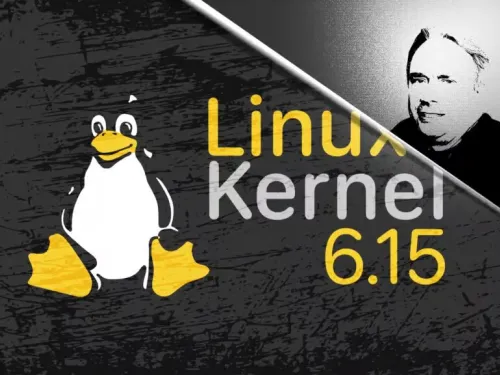
In May 2025, the Linux community witnessed a significant milestone in the evolution of the kernel: version 6.15 officially removed support for Intel i486 CPUs (80486 family) and early i586 processors, consolidating the definitive transition to more modern hardware. This decision, driven by debates on the LKML (Linux Kernel Mailing List) and implemented by Ingo Molnár, resulted in the removal of approximately 15,000 lines of legacy code. In this in-depth analysis, we examine the historical context of the i486 in the Linux ecosystem, the technical aspects involved in the discontinuation, the impacts on developers and retrocomputing enthusiasts, the available alternatives, and the possible future implications of this change.
Historical Context of i486 Support
Intel i486 processors debuted in 1989, introducing for the first time integrated L1 cache and a mathematical floating-point unit (FPU) in x86 family micros. In the early 1990s, they gained wide adoption in low-cost PCs, becoming the standard for commercial and home applications. As Linux matured, support for this architecture became fundamental, allowing distributions like Debian to offer the “i386” variant — which actually covered both 386 and 486 CPUs — ensuring compatibility with a vast installed base.
Still, by the turn of the 2010s, the use of machines equipped with i486 was rapidly declining. In 2024, only specialized distributions like MuLinux maintained legacy kernels to run on such old hardware. The lack of robust telemetry on i486 installations made it difficult to measure how many systems still depended on this architecture, but the general perception was that its practical relevance had run out.
Technical Aspects of Discontinuation in Kernel 6.15
Motivation and Debate on LKML
On April 25, 2025, Linus Torvalds expressed his view on the LKML, stating that “there's no real reason to waste development effort on the i486.” This position echoed concerns about code “bloat” and the maintenance of routines increasingly rarely used. A few weeks later, on May 7, 2025, Ingo Molnár submitted the patch that removed about 15,000 lines of support for legacy 486 and early 586 instructions, mandatorily focusing on TSC (Time Stamp Counter) and CMPXCHG8B minimum requirements, present only in Pentium or superior processors.
Main Changes in the Code
| Item Removed | Description |
|---|---|
| Support for specific i486 instructions | Initialization, cache handling, and exception handling routines exclusive to the 80486 family |
| Early 586 (Pentium 1) backport | Compatibility code aimed at supporting processors below the original Pentium |
| CPU checks in arch/x86 | Code snippets in the arch/x86 tree that detected and adapted features for 486 CPUs |
| Integration and emulation tests | Routines for emulating instructions not supported in modern x86, used only for backward compatibility |
By raising the minimum instruction requirements to CMPXCHG8B and TSC, kernel 6.15 ensures greater consistency in performance of synchronization and timing tasks, and reduces the maintenance surface for obsolete instructions.
Impact on the Open Source Community and Retrocomputing
For most Linux users on modern desktops, servers, and embedded systems, the lack of i486 support goes unnoticed. However, retrocomputing enthusiasts and projects dedicated to reviving vintage hardware directly felt the change. Distributions such as MuLinux, which specifically targeted i486 CPUs, will need to continue relying on previous kernel versions or release their own forks.
Moreover, the discontinuation reinforces the pragmatic nature of Linux kernel maintenance: focusing effort on widely-used features and the challenges posed by new architectures such as RISC-V and ARM64. The removal of legacy code also minimizes potential vulnerabilities emerging from routines long without continuous auditing.
Alternatives and Paths for Legacy Hardware Users
Although the official kernel 6.15 no longer supports the i486, there are viable alternatives:
Community Backports and Forks
Independent projects can maintain old kernel branches, applying security patches when necessary. This, however, requires continuous dedication from maintainers.Specialized Distributions
- MuLinux: designed for vintage hardware from the 1980s, runs on i486 but, having static code, lacks security updates.
- Other retro options: MenuetOS, KolibriOS, and Visopsys cater to old machines but require at least Pentium processors and do not use the Linux kernel.
Virtualization and Emulation
To develop or experiment with legacy software, tools like QEMU allow emulating i486 CPUs on modern hosts. Thus, there is no need to maintain physical hardware, taking advantage of snapshots and portability.
Future Implications and Perspectives
The decision to remove i486 support in kernel 6.15 reflects larger trends in operating system development:
Focus on Security and Performance
Less legacy code means a smaller attack surface and better optimization of compile and run time.Evolution of Architectures
With the growth of RISC-V and the consolidation of ARM64 in datacenters, simplifying the x86 tree expands the kernel's adaptability to new microarchitectures.Sustainability of Development
Maintainers focus resources on high-impact features for most users, optimizing release cycles and reducing technical debt.
Nonetheless, the challenge of preserving computing history remains. Retrocomputing communities will continue to value each obsolete platform, requiring parallel initiatives to keep the ability to run classic software alive.
Comparative Table of Support in Linux Distributions (2024–2025)
| Distribution | i486 Support in 2024 | Current Minimum Architecture |
|---|---|---|
| Debian | Yes (i386) | i486 |
| Ubuntu (20.04+) | No (requires i686 or higher) | i686 |
| MX Linux | No | i686 |
| MuLinux | Yes | i486 |
| MenuetOS/KolibriOS | No (minimum Pentium) | Pentium |
Conclusion
The removal of support for i486 chips in Linux 6.15 seals a cycle started over three decades ago. While it marks the end of an era, this change is consistent with technological evolution and the development community's priorities: maintaining a lean, secure kernel aligned with current hardware. For retrocomputing enthusiasts, opportunities arise to create forks or resort to emulation, ensuring that the legacy of the i486 remains accessible. As it mes
Add new comment